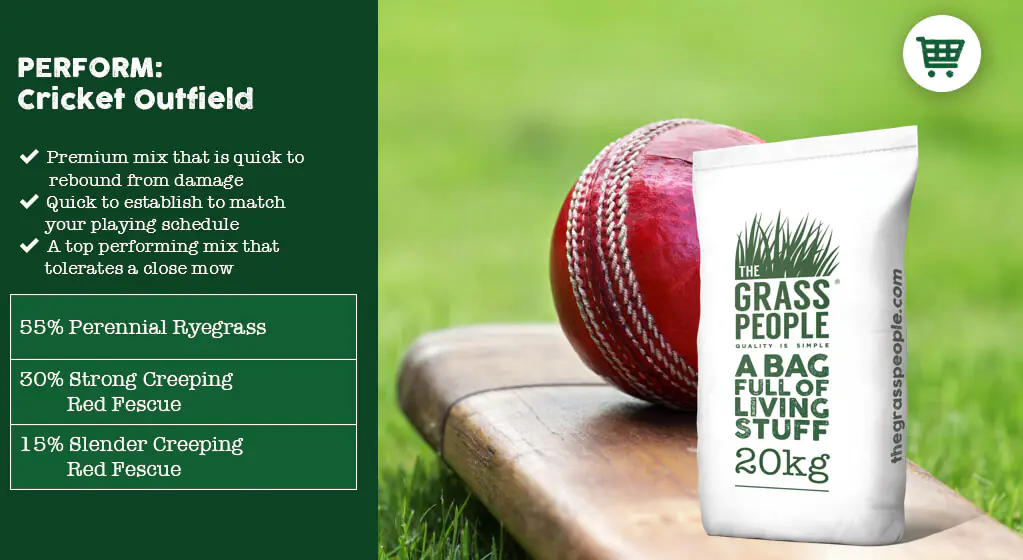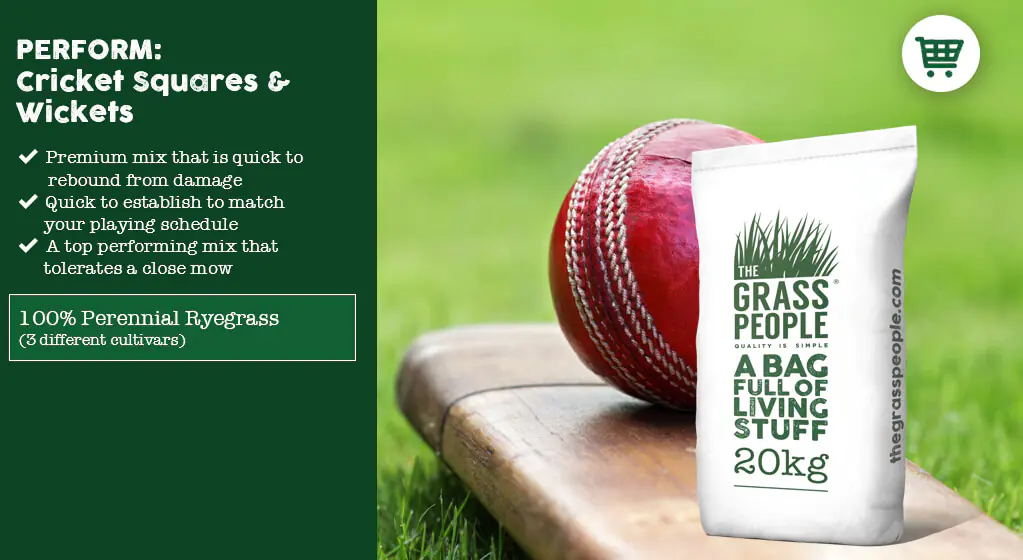How to manage your cricket grounds

Maintaining the pristine finish of a high-end cricket ground isn’t an easy task, especially with pitches in use for long periods of the spring and summer months. A well-managed pitch will ensure a fast, true and most importantly fair bounce which is vital in cricket.
Which seed?
There are many different varieties of grass seed available with a wide range of traits, suitable for just about every need whether it be gardening, landscaping or maintaining sports pitches. Finding the right mix for a particular job can be a challenge. At The Grass People we’ve created two mixes specifically for cricket grounds. One for squares and wickets and the other for the outfield areas of the pitch. The former contains three cultivars of perennial ryegrass specifically designed to create a durable, even finish. The latter is a fine, high quality mix of perennial ryegrass and fescues which allows for a low cut and can withstand the usual wear and tear of the cricket season. At the end of a busy playing season it’s important to take note of the pitch’s condition. On some occasions a full reseed may be the best option to deal with extensive damage, if damage isn’t too severe then smaller repairs can be carried out to get the field back to its best. Either way, the correct seed will be required no matter the renovation process so best to start off on the right foot.
New Pitch
Sowing a new cricket field is a large task and may require the use of a contractor to get the field fit for sowing. The soil needs to be of good depth and level to allow a good bed for the seed, it needs to be well flattened, aerated and moistened to create the best conditions for growth. When sowing a new field, we recommend a rate of 35g per square metre.
Existing Pitch
When renovating the damaged or bare patches in an existing rugby or football field the PERFORM: Cricket Outfield and PERFORM: Cricket Squares & Wickets will allow groundsmen to rejuvenate damaged grass quickly. To ensure the best possible surface for your field make sure to irrigate prior to overseeding. We recommend a sowing rate of 25g per square metre when overseeding.


Good practices
There are a wide variety of practices which should be considered when managing the upkeep of a cricket pitch. Scarification, aeration, regular mowing and applying fertiliser are all required for the perfect green, particularly in the off season when grass growth should be encouraged in preparation for the following season.
Aeration
Aeration is an important practice for maintaining any pitch. The process allows air and water to flow freely through the soil, ensuring grass roots receive plenty of both. Frequency depends on the method of aeration, whether it be spiking, slitting or coring. Spiking involves creating holes at a depth of 30mm using a garden fork and this should be carried out on a yearly basis. Slitting can be done more regularly as it does minimal cosmetic damage to the surface of the soil, take care not to overdo this job in case the pith becomes unsightly, though once a month is a good frequency to aim for. Coring should be done once every 3 years, in the off season, this involves using a corer to remove cylinders of soil from the ground, allowing soil space to breath and therefore reducing compaction.
Scarification
Scarification is a great way to remove thatch from cricket pitches and keeps the area looking fresh and healthy. This is best carried out using an automated scarifier and should be done at the end of the playing season as it will also clear the area of debris and make any repair work easier.
Mowing
Mowing should be a very regular activity on any sports ground. Not only does it keep the pitch looking great, it also ensures play remains fair and encourages further grass growth. One of the most under valued pitch care practices but undoubtedly one of the most important, our mixes are designed with short mowing in mind, to ensure the field can be kept neat during the season.
Feeding
Generally speaking, the best approach to nutrition in sports pitches is little and often. The correct feeding regime can vary depending on location, soil type and climate so make sure it’s right for your pitch before purchasing or applying fertiliser. The best place to start is with a simple soil test which can highlight the levels of nutrient and trace elements in the soil; this makes finding the right fertiliser much easier. The three most important nutrients required by grass are Nitrogen, Phosphate and Potassium, all of which are found, in different quantities, in general use fertilisers so soil test results should be used to make sure you apply the right one for you.
Maintenance Calendar
January
Brushing: Brush the surface of playing areas to remove dew and reduce the chance of disease.
Mowing: Keep winter mowing to a minimum but don’t let grass grow too long or it can become weak. Frequency will depend on weather and general condition of the pitch.
Aeration: Carry out some light slitting work at this time of year, heavier aeration is also an option but take care to not overdo it on wetter soils.
February
Rolling: You may want to start rolling earlier than usual if your season starts in April, otherwise it’s best to leave this until March.
Sampling: Get your soils sampled for nutrients so you can start preparing for the right fertiliser application.
Weeds, pests and disease: Take time to assess the presence of all of these pesky problems and apply the correct solution where necessary.
March
Brushing: Continue the brushing routine on a regularMarking: ‘Square off’ the areas used for squares with a semi-permanent marking. Continue with brushing and lower mow height to 18mm, but be sure to avoid taking more than a third of the grass height off in a single cut.
Rolling: March is the time to start pre-season rolling, if you haven’t already. Consolidation depends on the clay content of soils, the more clay the heavier the regime applied will have to be.
April
April is a very busy time for cricket groundskeepers, but better weather and longer evenings should give more time to complete tasks that need doing.
Early April: Continue with mowing, squaring, brushing and rolling work, all of which will need to be kicked up a gear to ensure the pitch is ready for the first games of the season.
Late April: Reduce mowing height to 10-12mm to encourage sward density. Ensure the irrigation system is in working order and make sure it is ready for use.
May
Agronomy: Monitor the performance of the pitch closely, adjusting care routines where appropriate and required.
Weeds, pests and diseases: Keep an eye open at all times for any of these cropping up. The most common problems are fusarium, red thread and pests such as chafer grubs and leatherjackets.
General tasks: Keep on top of the common brushing and mowing tasks as always.
June
General maintenance: Keep on top of irrigation and the usual ‘menial’ tasks all throughout the playing season, particularly in the warmer months June, July and august.
Wicket care: You should have seen a month or two of play on the pitch by this stage so it’s important to assess the condition of the wickets. Brushing, sweeping, scarifying and aeration practices should be maintained to keep the grass looking good and performing well.
Outfield: Similarly, outfield care should remain high on the list of priorities with similar care being taken and areas repaired as necessary.
July
Fertiliser: Apply a slow release fertiliser to keep the pitch fed for the next month or two of the playing seasonContinue with general maintenance as in previous months.
August
Much the same as July, continue with general maintenance, mowing, scarifying and some light aeration in the form of slitting if possible.
September
Brushing: Increase the brushing frequency this month as dew on the grass can increase the chances of disease
General care: Care will now move towards renovation of the pitch, September is a good month for heavier ground work as the ground should be in good enough condition to not cause severe poaching. Scarification and feeding should still be high on the to-do-list. Areas that require repairs or reseeds should be addressed, particularly areas like squares and wickets.
Aeration: A heavier method of aeration should be done at this time whether that be spiking or coring.
October
Sampling: October is another great time to test soils if you haven’t done this for some time. If any changes in composition have occurred they can be addressed over the winter period for the following season.
Rolling: This can be resumed in the off season to keep swards dense
November
Mowing: Grass growth should slow down at this time and mowing should become less frequent. Ensure grass doesn’t grow too high but otherwise keep mowing to a minimum.
Other maintenance: Winter is a great time to start working on other areas, such as repairing and painting posts or other features of your cricket grounds. Brushing should still be carried out as usual
December
Much like November, December is a slower month and despite the usual brushing and perhaps the odd mow pitch maintenance shouldn’t be too demanding.